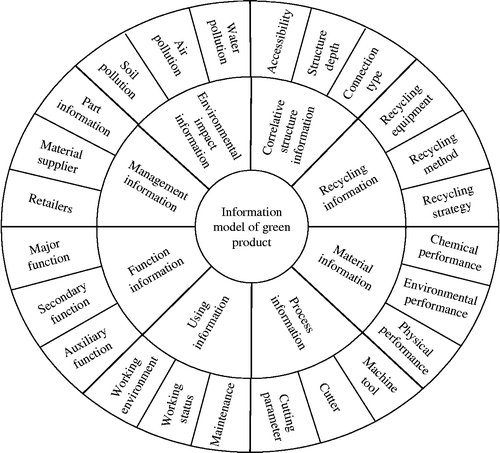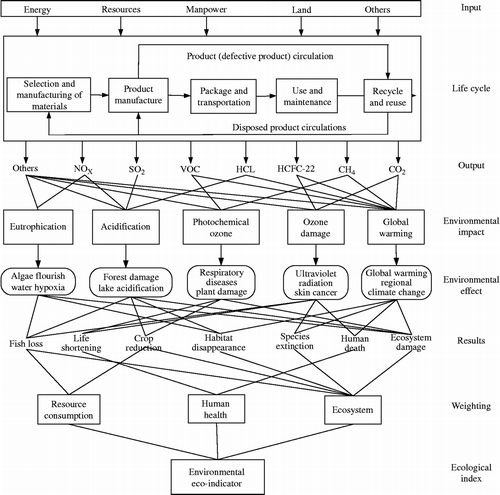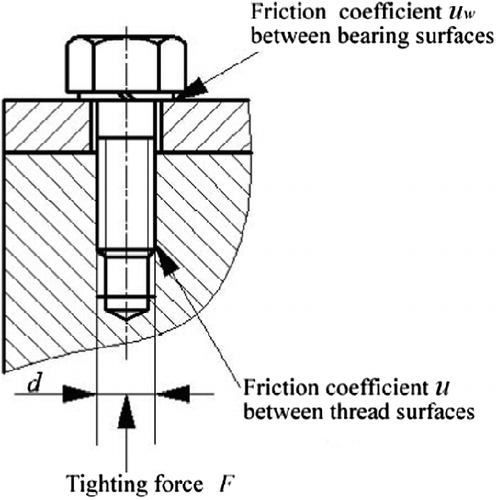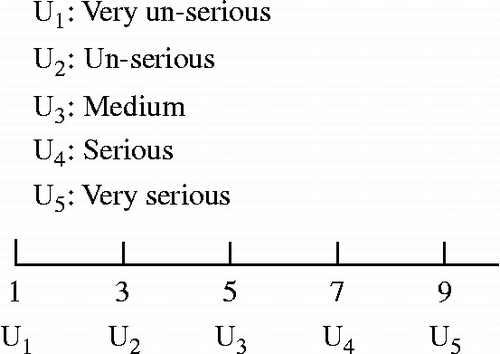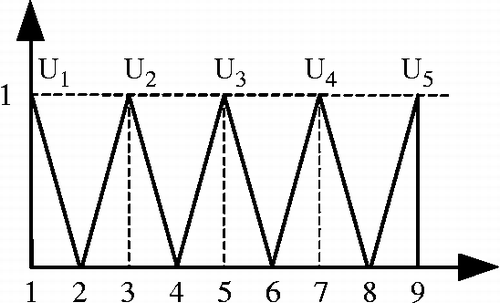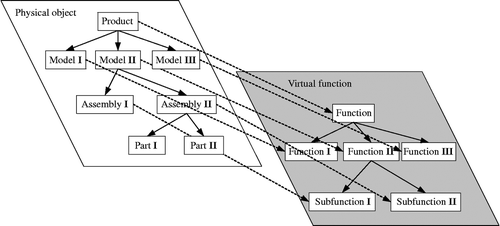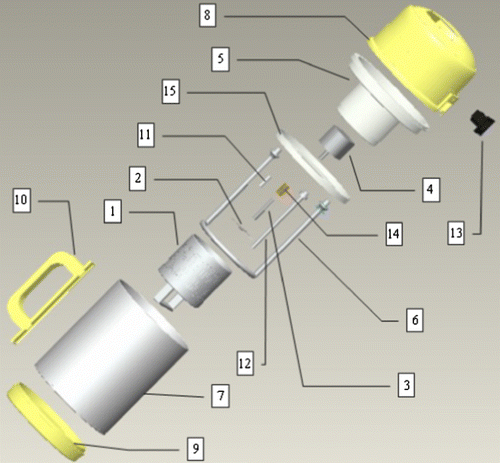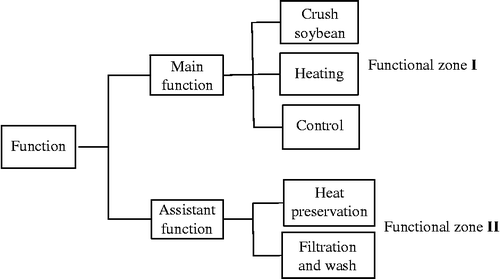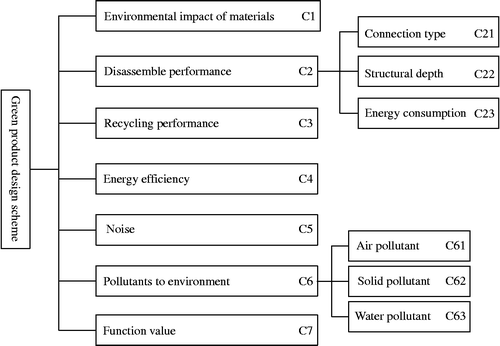Abstract
The function, cost and environmental performance are the primary decision-making factors for scheme selection in green design. For the comprehensive and accurate decision-making in selecting green product design scheme, a quantitative analysis method of multi-attribute decision-making (MADM) is presented. With analysing the multi-attribute of scheme selection, the MADM model is established, which takes environmental impact of materials, disassembly performance, recycling performance, energy efficiency, noise, pollutants to environmental and functional values. Fuzzy technique for order performance by similarity to ideal solution method is applied to solve this model for the feasible solutions. Finally, a case study is given to validate the application of this methodology as a useful design guideline for scheme selection in green design.
1. Introduction
With the high development of science and technology, the productive ability in manufacturing is greatly improved, and the amount and types of products are gradually increased, which has enriched consumers' needs. However, with the high speed of the technology innovation, the updation in the products is apparently accelerated. Thus, the environmental problems are more serious. In response to the pressure of resources, energy and environment, many countries have legislated to protect the environment in the world, such as RoHS (Restriction of the Use of Certain Hazardous Substances in Electrical and Electronic Equipment; Tian and Ma Citation2003, Wang Citation2004), WEEE (Waste Electrical and Electronic Equipment; Tian and Ma Citation2003, Wang Citation2004) and EuP (Eco-design Requirements for Energy-using Products Directive; Liu and Wang Citation2006). Meanwhile, the consumers gradually tend to purchase the environmental friendly products.
Judging from the experience, decision making at the conceptual design stage has critical influence on function, cost and environmental performance in the product life cycle. Solving the multi-attribute problems can provide a better support for decision-making in green product design scheme. Technique for order performance by similarity to ideal solution (TOPSIS) is a useful technique in dealing with multi-attribute or multi-criteria decision-making (MADM/MCDM) problems in the real world (Hwang and Yoon Citation1981). It helps decision maker(s) (DMs) to carry out analysis, comparisons and rankings of the alternatives, and the selection of a suitable alternative(s) will be made. TOPSIS advantages are as follows (Shih et al. Citation2007): (i) a sound logic that represents the rationale of human choice; (ii) a scalar value that accounts for both the best and worst alternatives simultaneously; and (iii) a simple computation process that can be easily programmed into a spreadsheet. These advantages make TOPSIS a major MADM technique that can be compared with other related techniques such as analytical hierarchical process (AHP) and ELECTRE; therefore, it is widely applied in many fields. In surface engineering, coatings can protect and improve the mechanical characteristics of part surfaces; Athanasopoulos et al. (Citation2009) applied the MADM method into the selection of coating to improve the accuracy and rationality of coatings selection. In the establishment of a supply chain, Fatih et al. (Citation2009) solved the multi-attribute group decision-making problem by applying the MADM method during the selection process of suppliers. Zhang and Liu (Citation2000) presented the MADM model of green manufacturing process planning, which aims at multi-attribute optimisation, including time (T), quality (Q), cost (C), resource consumption (R) and environmental impact (E). Considering the shortcomings in single conflict resolution, Meng and Hong (Citation2005) used the concept of multi-attribute vector space to describe the mathematical form of the conflict problem, and used optimised arithmetic of MADM to resolve the mathematical model. Huang and Liu (Citation2006) built the MADM model for materials selection from cost and environmental impact of materials (MEI), and solved the problem of materials selection in green design.
Due to the vagueness and inadequate information, personal experience and judgements, DMs may find it hard to make the best choice. Based on the fuzzy set theory, the fuzzy TOPSIS method has been widely applied to solve this problem in various fields in recent years. Kahraman et al. (Citation2007) established a hierarchical structure of the industrial robotic systems, which had technical and economical factors according to the fuzzy hierarchical TOPSIS model. In order to deal with the problem of supplier selection in the supply chain system, Chen et al. (Citation2006) developed a fuzzy decision-making approach to evaluate the ratings and weights for many quantitative and qualitative factors from price, quality and flexibility. The ranking order of all suppliers can be calculated through fuzzy TOPSIS. Tsaur et al. (Citation2002) evaluated the service quality of airlines from some factors such as safety, comfort and courtesy, and ranked by the fuzzy TOPSIS method, the weights of these factors were calculated by the AHP.
Scheme selection in green design is a multi-attribute problem, because designers should consider aspects such as MEI, disassembly performance, recycling performance, etc. when they select the optimum scheme. The attributes of green design scheme also include quantitative and qualitative factors, so the designers may meet the fuzziness and uncertainty problems when they evaluate these attributes. Thus, in this paper, the fuzzy TOPSIS method is proposed to solve decision-making problems of scheme selection in green design and a multi-attribute analysis model from seven key factors, and the weights of these factors can be obtained by the fuzzy AHP that provides more objective and accurate criterion weights. The proposed method is well suited for evaluating the fuzziness and uncertainty problems of scheme selection in green design.
2. Information model of green product
Green product is a kind of product that has no or little harmful performance on ecological environment, and has a higher rate of resource and energy utilisation. The concept of green product is a whole product's life cycle rather than a certain process or stage, so the information model of green product should meet the following requirements:
-
include the information of fundamental function and structure;
-
include the fundamental information of the product's life cycle; and
-
provide data for environmental performance assessment.
Figure shows the information model of green product, it mainly includes management information, function information, using information, process information, material information, recycling information, correlative structure information and environmental impact information.
Management information. Management information is related to the information of components, such as names, codes, amounts, technical specifications and so on. It also includes the information of manufacturing departments, suppliers of parts and materials, retailers and collectors.
Function information. The function means the subject (it mainly refers to the products here) that is an attribute which can satisfy some needs (Li Citation1993). Function can be interpreted as use, effect, performance, etc. Each product has the specific function for itself, otherwise the product has no value for being in existence.
Using information. Using information should include the working environment, working status, maintenance, etc.
Process information. Process information describes the process of manufacturing (including cutting parameter, cutter, fixtures, machine tool, etc.), assembly, recycling and so on.
Material information. Material information describes composition, physical and chemical indicators, methods and conditions of heat treatment, process performance of processing and environmental performance. Environmental performance mainly reflects the whole product's life cycle, such as the stage of manufacturing, using, recycling, etc.
Recycling information. Recycling information mainly includes the recycling strategy, methods, equipment, etc. Recycling information is mainly used to support design for recycling, which increases the rate of resource reusing.
Correlative structure information. Although specific sizes and detailed structures cannot be determined in the design stage of product scheme, basic correlative structures should be defined in order to support the assessment of disassembly performance (Guo Citation2006).
Environmental impact information. Environmental information is a set of environmental load during the product's life cycle. It includes the depletion information of resource and energy, the emission information of pollution and the negative influence on atmosphere, water, soil, humans, etc.
3. Environmental performance analysis of green product design schemes
3.1 Environmental impact of materials
Negative MEI is the main impact factor of direct or indirect damage and destruction to the environment. During the entire materials process, waste gas, waste water and other forms of pollution are inevitably produced with the physical or chemical change. According to statistics, one-third to one-half of all industry pollution is generated during the manufacturing processes of production (Liu Citation2002). As a result, the MEI should be considered as a decision variable, and the life cycle assessment (LCA) method could be used to analyse and access the MEI.
Currently, LCA is a very widely used method to assess environmental impact, and many domestic and foreign institutes have researched about LCA. The Dutch Eco-Indicator'95 and Eco-Indicator'99 are widely accepted methods for environmental impact assessment, and Figure shows the assessment model of Eco-Indicator'99.
In Eco-Indicator'99, the value of environmental impact is presented by the ecological index (unit: mPt/kg). Table shows the ecological index of polypropylene (PP) in different life cycle stages.
Table 1 Ecological index polypropylene (PP) (Goedkoop et al. Citation2000).
The MEI can be calculated by Equation (Equation1)
3.2 Disassembly performance
Poor product disassembly performance will waste a large number of reusable components and materials, as well as cause the environmental pollution when the products reach their end-of-life. Disassembly performance is assessed by three criteria: connection type, structure depth and energy consumption.
3.2.1 Connection type factor
Connection type reflects how difficult it is to destroy the connection. The connection type can be calculated by Equation (Equation2).
Table 2 Parts connection interactive index (Zhang et al. Citation2008).
3.2.2 Structural depth factor
Structural depth of parts indicates the relative positions between two parts. When a part is directly connected with the standard part, its structural depth is ‘1’; when a part is connected with the standard part by another part, its structural depth is ‘2’. Therefore, a part's disassembly performance is related to its structural depth. The structural depth of parts can be calculated by Equation (Equation3).
3.2.3 Energy consumption of disassembly
Obviously, disassembly needs energy consumption. Taking threaded connection as an example (see Figure ), its energy consumption in the disassembly process can be calculated by Equations (Equation4) and (Equation5
) (Liu et al.
Citation1999).
The factor of disassembly energy consumption can be calculated by Equation (Equation6).
3.3 Recycling performance
Recycling performance describes the product's recyclability. The analysis and assessment of recycling performance of product can increase the rate of recycling and reusing, and reduce the production of waste. In this paper, the recycling performance is analysed from two aspects of recycling methods and key factors (Table ).
Table 3 Analysis of product recycling methods and key factors.
The recyclability can be calculated by Equation (Equation7).
3.4 Energy efficiency
China is not only a country that manufactures a huge amount of products, but also a country that consumes a huge amount of products. Facing the problem of immoderate energy consumption, the energy efficiency should be considered at the design stage.
According to the model of energy consumption in Figure , the energy efficiency can be calculated by Equation (Equation8).
3.5 Noise
Harm to human beings caused by noise is directly related to the strength of noise. A standard for noise has been drafted in China. The assessment of noise is carried out according to Table .
Table 4 Noise grading standard (The State standard of PRC, Noise standards for cities, GB3096-93.)
3.6 Pollutants to the environment
Pollutants emitted to the environment can be assessed by three criteria which are air pollution, water pollution and soil pollution. Air pollution is mainly caused by harmful gases such as carbon dioxide, nitrogen oxides, hydrocarbons, etc. Water pollution is mainly caused by sewage, waste water and heavy metals such as mercury, chromium and lead, etc. Soil pollution is mainly caused by the plastics pollution, electronic waste, construction waste, etc. We use triangular fuzzy number (see Figure ) to express the importance of each criterion. The linguistic terms (see Figure ) range from ‘very unserious’ to ‘very serious’. The specific term ‘very’ is utilised to stress the degree of each criterion (Figure ).
4. The analysis and assessment of the function value (FV)
It is possible that a number of design schemes could be generated to meet the customers' requirements, but the ways to achieve the same function or performance are different, as well as the cost. Therefore, a method is needed to measure the relationship between the cost and the functions of products, named value analysis (VA). The value of product is reflected by functions and cost, and the function can be realised by the different combination of parts (see Figure ), so the product value can be converted into the function or parts value.
In VA, the value is expressed by the ratio between the function and cost, which can be described by Equation (9).
4.1 Function value index method
The function value (FV) index method adopts ways to compare the functions, and gives scores according to the importance of functions. The FV can be obtained by making a ratio between the function important index and function cost.
4.1.1 Calculation of the function important index
The function important index can be abbreviated to function index (FI), which could be used as an expression of graded functional importance. There are many ways to give the grade to function, such as the direct grade method, force decisions (FD) method and ‘04’ grade method. The FD method is a general method, but it has some flaws (Meng and Hong Citation2005). Thus, a standard product is inputted into the FD method to improve the original method and offset these flaws.
First of all, the product's functions are listed one by one in the first column of the table, and the score of the standard product's function is 5. Then, the functions of the product, requiring evaluation, are compared to the standard product's functions one by one, and the values are inputted into the third column of the table. If the function of the product is better than the standard product's, the value is greater than 5. If the function of the product is as good as the standard product's, then the value is 5. If the function of the product is worse than the standard product's, then the value is less than 5. The improved FD method can be seen in Table , and the value of the second column is the weight accorded to the function.
Table 5 The improved method to calculate the FI.
Then, the FI of product I can be calculated by Equation (Equation10).
4.1.2 Calculation of the function cost
The function cost is the sum of the cost of parts that realise some function, it can be calculated by Equation (Equation11).
5. Fuzzy TOPSIS method
In this paper, the fuzzy TOPSIS method is proposed for evaluation of the performance of the green design scheme. The merit of fuzzy TOPSIS is to evaluate the attributes using fuzzy numbers instead of precise numbers for suiting the real world in fuzzy environment. Based on the concept, the best option should have the shortest distance from the positive-ideal solution and the longest distance from the negative-ideal solution. The steps in the fuzzy TOPSIS method follow:
Step 1: Determine the weighting of evaluation criteria.
This study employs the fuzzy AHP (Pan Citation2008) to calculate the weights of criteria using fuzzy numbers for the pair-wise comparisons.
Step 2: Construct the fuzzy decision matrix and choose the appropriate linguistic variables for the alternatives with respect to criteria.
Step 3: Normalise the fuzzy decision matrix.
For fuzzy data denoted by triangular fuzzy number as (a ij , b ij , c ij ), the normalised values for benefit-related criteria and cost-related criteria are calculated as follows:
For non-fuzzy data, the normalised values for benefit-related criteria and cost-related criteria are calculated as follows:
Step 4: Calculate the overall performance evaluation for each alternative by multiplying the aggregate weights for each normalised criteria.
For fuzzy data
For non-fuzzy data
Step 5: Determine the fuzzy positive-ideal solution (FPIS) and fuzzy negative-ideal solution (FNIS).
For fuzzy data
For non-fuzzy data
Step 6: Calculate the distance of each alternative from the FPIS and FNIS.
For fuzzy data
The distances ( and
) of each alternative from
and
can be currently calculated by the area compensation method.
For non-fuzzy data
The distances ( and
) of each alternative from
and
can be currently calculated by the area compensation method.
Step 7: Calculate the closeness coefficient (CC) and rank each CC of each alternative in descending order. The alternative with the highest CC value will be the best choice.
6. Example
The customer requirements of soybean crusher were collected and, the main requirements were easy handling, less leavings, high safety, reliability and durability, easy to clean, etc. Eight schemes were established according to the customers' requirements (Table ).
Table 6 Schemes for soybean crusher.
6.1 Analysis and assessment of green performance for schemes
For this paper, only the calculation of Scheme 6 has been explained.
6.1.1 Environmental impact of materials
The explosive view of Scheme 6 is shown in Figure , and the materials and weights of components are listed in Table .
Table 7 The materials and weights of the components.
According to Equation (Equation1), the environmental impact of the recycling process for PP can be calculated as follows:
Then, the life cycle environmental impact of PP is
According to the data in Table , the MEI value of Scheme 6 is 604.95 (mPt).
Table 8 The material impact on environment.
6.1.2 Disassembly performance
(1) The factor of connection type and the energy consumption.
The interactive index of connection types and the energy consumption to disassembly for Scheme 6 are listed in Table .
Table 9 The connection type factor and the energy consumption factor for Scheme 6.
The connection type factor can be calculated by Equation (Equation2): CT = 0.71. The energy consumption to disassembly can be calculated by Equation (Equation6
): EC = 3.59.
(2) The factor of structural depth.
Establishing the structural relationship (Figure ) of the parts based on the cover of bottom, the structural depth of components is calculated according to the structure of Scheme 6.
According to Table , the structural depth factor can be calculated by Equation (Equation3): SD = 1.80.
Table 10 The structural depth of components.
6.1.3 Recycling performance
Table of the recycling way of the components is built. The recycling performance can be calculated by Equation (Equation7): RP = 0.62.
Table 11 The recycling measures of the components.
6.1.4 The energy efficiency
The energy efficiency of the soybean crusher when in use can be described by the volume of soybean milk produced per unit of power. The energy consumption of the soybean crusher can be mainly divided into two parts: the consumption during soybean crushing and the consumption during heating of the soybean milk. The crushing process lasted for 4 min, the power of the motor is 180 W; the heating process lasted for 14 min and the power of electric thermal pipe is 700 W. The volume of cup is 1.3 litre, so the energy consumption in producing 1.3 litre of soybean milk is 0.175 kWh. In summary, 7.3 litres of soybean milk can be produced by 1 kWh, EE = 7.43 l/kWh.
6.1.5 The noise
The noise from the soybean crusher is mainly from the process of crushing, and directly related to the type of blade. As the ‘X’-shaped blade is used in Scheme 6, the noise range is 61–64 dB. According to the standard in Table , the score of noise is 3 points: UN = 3.
6.2 Value analysis
The functional system diagram of Scheme 6 (see Figure ) is drawn according to the Function Analysis System Technique.
Step 1: Calculation of the FI.
Firstly, the functions of the standard product are defined: (‘1’-shaped blade, shaft coupling+motor, electric thermal pipe heating, manual control, common steel wire strainer, stainless steel cup). Table is constructed according to the improved FD method, and the relative function importance of Scheme 6 is determined by Table .
Table 12 The improved method to calculate the FI.
Table 13 The features of different structures.
Step 2: Calculation of the function cost.
The parts are classified according to the functions in Table .
Table 14 Function cost.
Step 3: Calculation of the FV of Scheme 6.
The FV of Scheme 6 is calculated according to Equation (Equation12): FV = 0.251.
6.3 Election of the optimal green design scheme
Step 1: Determine the weighting of the evaluation criteria.
The weights of the criteria to be used in the evaluation process are calculated using the Fuzzy AHP method. Figure shows the Fuzzy AHP model of criteria, and one product designer, one environment engineer and one material engineer are involved to evaluate the weights of criteria. The overall weights of each criterion are shown in Table .
Table 15 Overall weights of each criterion.
Step 2: Construct the fuzzy decision matrix and choose the appropriate linguistic variables for the alternatives with respect to criteria.
The fuzzy decision matrix is shown in Table .
Table 16 Evaluation matrix for the alternative schemes.
Step 3: Normalise the fuzzy decision matrix.
Using Equations (Equation14)–(Equation16
), we can normalise the fuzzy decision matrix in Table .
Table 17 Normalised fuzzy-decision matrix.
Step 4: Establish the weighted normalised fuzzy decision matrix.
The fourth step in the analysis is to find the weighted fuzzy decision matrix, and the resulting fuzzy weighted decision matrix is shown in Table .
Table 18 Weighted normalised fuzzy-decision matrix.
Step 5: Estimating the performance and ranking the alternatives.
Using Equations (Equation21)–(Equation25
), we can calculate the CCs of each of the alternatives d
+, d
− and CC. Finally, we can rank alternatives according to the CC, the results are shown in Table .
Table 19 Closeness coefficient table.
According to C i , a sequence of feasible solutions can be obtained: x 6>x 4>x 8>x 2>x 5>x 7>x 1>x 3, so Scheme 6 is the best.
6.4 Result analysis
-
In the eight schemes, the FV of Scheme 7 (0.267) is the best if only considering the function and cost, mainly because of the using of heat-resisting polyester material cup which has a low price and good performance of heat preservation. However, the heat-resisting polyester material cup has a worse environmental and recycling performance. So, Scheme 7 has an inferior decision-making to Scheme 6 from comprehensive aspects of the environmental performance.
-
When the fuzzy decision matrix is normalised, the weight will vary according to different DMs. Even if the weight is determined by the same DMs, the weight is also uncertain to some extent. In order to solve the negative impact on decision-making caused by the uncertainties, the fuzzy AHP method can effectively support the group decision-making and provide more objective and accurate criterion weights.
-
However, the conclusion depends on the accuracy of the data. In this article, a lot of environmental data came from the Eco-Indicator'99 that was based on other countries. The Eco-Indicator'99 is not entirely suitable for the Chinese environment. In order to improve the accuracy of decision-making, a database for China should be established.
7. Conclusions
The aim of this research was to construct a fuzzy TOPSIS model to evaluate a set of feasible green design alternatives with more than one criterion to determine a priority ranking for alternatives selection. MEI, disassembly performance, recycling performance, energy efficiency, noise, pollutants to the environment and functional value were analysed in the performance evaluation for the product green design scheme selection. Considering these factors, a final evaluation ranking for priority was generated among these green design schemes of the proposed model. Because of vagueness and inadequate information, personal experience and judgements in the selection of green design schemes, the uncertainty of human decision-making was taken into account through the fuzzy concept in fuzzy environment. The weights of each criterion were calculated using the fuzzy AHP to support group decision-making, which solved the problem of the weight calculation in the fuzzy TOPSIS method. The priority ranking for alternatives was determined by the fuzzy TOPSIS method that can determine the key criterion for the performance and measure the relationships among these evaluation criteria. Moreover, the integrated evaluation method was presented to solve the imprecision problem of traditional performance evaluation model with a fuzzy point of view, and the decision analysis could be better undertaken in the complete evaluation process. Furthermore, the paper proposes a more accurate, effective, logistic and systematic decision support approach to help designers to select the optimal green design scheme.
Acknowledgements
This work was financially supported by several projects including: the National Natural Science Foundation Project (50775061), ‘863’-Hi-Tech Research and Development Program of China (2007AA04Z123) and Major scientific and technological special projects of Guangdong Province (2009A080305005) which are gratefully acknowledged.
References
- Athanasopoulos , G. , Romeva Riba , C. and Athanasopoulou , C. 2009 . A decision support system for coating selection based on fuzzy logic and multi-criteria decision making . Expert Systems with Applications , 36 ( 8 ) : 10848 – 10853 .
- Chen , T. , Lin , C.T. and Huang , S.F. 2006 . A fuzzy approach for supplier evaluation and selection in supply chain management . International Journal of Production Economics , 102 : 289 – 301 .
- Fatih , E.B. 2009 . A multi-criteria intuitionistic fuzzy group decision making for supplier selection with TOPSIS method . Expert Systems with Applications , 36 ( 8 ) : 11363 – 11368 .
- Goedkoop , M. , Effting , S. and Collingo , M. 2000 . The Eco-Indicator'99 – a damage oriented method for Life Cycle Impact Assessment-Manual for Designers , The Netherlands : Ministry of Housing, Spatial Planning and the Environment .
- Guo , W. 2006 . Research on process and method of conceptual design for green product , Hefei : Hefei University of Technology .
- Huang , H. and Liu , Z. 2006 . Research on multi-objective decision-making of materials selection in green design . Chinese Journal of Mechanical Engineering , 42 (8) : 131 – 136 .
- Hwang , C.L. and Yoon , K. 1981 . Multiple attribute decision making , Berlin : Springer-Verlag .
- Kahraman , C. 2007 . Fuzzy multi-criteria evaluation of industrial robotic systems . Computers & Industrial Engineering , 52 : 414 – 433 .
- Li , Z. 1993 . Development & value analysis of product , 1st ed. , Nanjing : Southeast University Press .
- Liu , G. , Liu , Z. and Li , G. 1999 . Green design & green manufacture [M] , Beijing : China Machine Press .
- Liu , J. 2002 . Material impact on environment , 1st ed. , Beijing : Science Press .
- Liu , X. and Wang , L. 2006 . A new green wave in the European Union . China WTO Tribune WTO , : 1 – 2 .
- Meng , X. and Hong , Y. 2005 . Research on conflict resolution method based on multi-objective decision-making in collaborative design . Computer Integrated Manufacturing Systems , 11 ( 5 ) : 625 – 629 .
- Pan , N.-F. 2008 . Fuzzy AHP approach for selecting the suitable bridge construction method . Automation in Construction , 17 ( 8 ) : 958 – 965 .
- Shih , H.-S. , Shyur , H.J. and Lee , E.S. 2007 . An extension of TOPSIS for group decision making . Mathematical and Computer Modelling , 45 : 801 – 813 .
- Tian , L. and Ma , P. 2003 . The introduction about WEEE/ROHS of EU[J] . China Environmental Production Industry , : 34 – 37 .
- Tsaur , S.H. , Chang , T.Y. and Yen , C.H. 2002 . The evaluation of airline service quality by fuzzy MCDM . Tourism Management , 23 : 107 – 115 .
- Wang , H. 2004 . The implementation of WEEE and ROHS in EU . China Appliance , : 48 – 49 .
- Zhang , H. and Liu , F. 2000 . Decision-making model of green manufacturing process planning and the case study . China Mechanical Engineering , 11 ( 9 ) : 979 – 982 .
- Zhang , L. 2008 . Product optimizing configuration method oriented green design . Transactions of the Chinese Society for Agricultural Machinery , 39 ( 9 ) : 122 – 128 .
